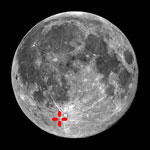|
 Longomontanus
est un cratère de 145 Km situé sur le plateau continental méridional au
sud-ouest du cratère Tycho. Il est appelé plaine murée, bien qu'il soit plus
une dépression circulaire dans la surface. En raison de sa position
Longomontanus apparaît sous forme ovale du fait de la perspective. La
muraille de Longomontanus est fortement érodée par des impacts. Le mur
Nord-ouest est particulièrement affecté par des craterlets plus ou moins
gros. A l'est de la muraille on trouve une arête semi-circulaire qui
représente un ancien cratère Longomontanus Z dont la partie ouest est
recouverte par Longomontanus. Le plancher du cratère Longomontanus est
relativement plat, avec des crêtes centrales légèrement excentrées vers
l'ouest. On note aussi la présence de nombreux craterlets et de taches
blanches.
Longomontanus
est un cratère de 145 Km situé sur le plateau continental méridional au
sud-ouest du cratère Tycho. Il est appelé plaine murée, bien qu'il soit plus
une dépression circulaire dans la surface. En raison de sa position
Longomontanus apparaît sous forme ovale du fait de la perspective. La
muraille de Longomontanus est fortement érodée par des impacts. Le mur
Nord-ouest est particulièrement affecté par des craterlets plus ou moins
gros. A l'est de la muraille on trouve une arête semi-circulaire qui
représente un ancien cratère Longomontanus Z dont la partie ouest est
recouverte par Longomontanus. Le plancher du cratère Longomontanus est
relativement plat, avec des crêtes centrales légèrement excentrées vers
l'ouest. On note aussi la présence de nombreux craterlets et de taches
blanches.
|
|
 (English version,
Wikipedia copyright)
(English version,
Wikipedia copyright)
Longomontanus
is an ancient lunar impact crater located in the rugged southern highlands
to the southwest of Tycho crater. It is of the variety of large lunar
formations sometimes called a "walled plain", although it is actually more
of a circular depression in the surface. Because of its location, the
Longomontanus appears distinctly oval in shape due to foreshortening.
To the southeast of Longomontanus is the even larger Clavius crater, and to
the east is Maginus crater. North of the rim is the irregular Montanari
crater, which in turn is joined at its northern rim by Wilhelm crater.
The wall of Longomontanus is heavily worn and incised by past impacts, and
the rim is essentially level with the surrounding terrain. The northern rim
especially is impacted with multiple overlapping craterlets. To the east of
the rim is a semi-circular ridge that has the appearance of an overlapped
crater rim. The crater floor of Longomontanus is relatively flat, with a low
cluster of central peaks somewhat offset to the west.
|



 Longomontanus
Longomontanus